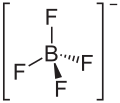| |||
| Names | |||
|---|---|---|---|
| IUPAC name
Lithium tetrafluoroborate
| |||
| Other names
Borate(1-), tetrafluoro-, lithium
| |||
| Identifiers | |||
3D model (JSmol)
|
|||
| ChemSpider | |||
| ECHA InfoCard | 100.034.692 | ||
PubChem CID
|
|||
| UNII | |||
CompTox Dashboard (EPA)
|
|||
| |||
| |||
| Properties | |||
| LiBF4 | |||
| Molar mass | 93.746 g/mol | ||
| Appearance | White/grey crystalline solid | ||
| Odor | odorless | ||
| Density | 0.852 g/cm3 solid | ||
| Melting point | 296.5 °C (565.7 °F; 569.6 K) | ||
| Boiling point | decomposes | ||
| Very soluble[1] | |||
| Hazards | |||
| Occupational safety and health (OHS/OSH): | |||
Main hazards
|
Harmful, causes burns, hygroscopic. | ||
| NFPA 704 (fire diamond) | |||
| Safety data sheet (SDS) | External MSDS | ||
| Related compounds | |||
Other anions
|
Tetrafluoroborate, | ||
Related compounds
|
Nitrosyl tetrafluoroborate | ||
Except where otherwise noted, data are given for materials in their standard state (at 25 °C [77 °F], 100 kPa).
| |||
Lithium tetrafluoroborate is an inorganic compound with the formula LiBF4. It is a white crystalline powder. It has been extensively tested for use in commercial secondary batteries, an application that exploits its high solubility in nonpolar solvents.[2]
- ^ GFS-CHEMICALS Archived 2006-03-16 at the Wayback Machine
- ^ Xu, Kang. "Nonaqueous Liquid Electrolytes for Lithium-Based Rechargeable Batteries."Chemical Reviews 2004, volume 104, pp. 4303-418. doi:10.1021/cr030203g


